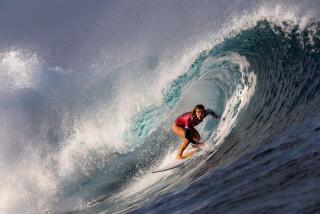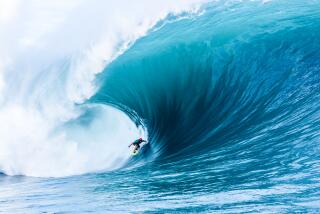A surfer’s defining moment in a wall of water
Driving along the southern coast of Tahiti that day, Nathan Fletcher saw things he had never seen before.
The waves broke so big and hard that seawater crashed through berms, surging inland, scattering bits of coral across the road. Villagers pedaled their bicycles out to watch.
Down at Teahupoo beach, a big-money contest with Kelly Slater and some of the best surfers in the world had been put on hold. Government officials had declared a “code red” for safety reasons.
“Nobody wanted those waves,” Fletcher said.
Nobody except him and his brethren, two dozen or so fanatics who specialize in riding monsters. Tipped off by the forecast, they had flown from various spots around the globe to gather in this remote town at the base of lush, green mountains.
Teahupoo — (pronounced Cho-pu) — produces one of the most thrilling and dangerous waves on the planet, massive amounts of water barreling over a gently sloped bottom, then smacking into a shallow reef. Its name translates roughly as “broken skulls.”
Fletcher now looks back on that morning and recalls that it felt momentous. For two years, he had been telling buddies that something like this was on the way. “I didn’t know what it was going to be or how it was going to be. I just knew it was going to be big.”
With enormous surf pounding the shoreline — “warning drums,” the locals called it — a primal mix of fear and excitement washed over him.
“Every nervous second thought you could have,” he said. “Like a frenzy.”
The date was Aug. 27, 2011, and his life was about to change.
::
If you don’t surf, the name might not ring a bell. But if you do, Fletcher and his family qualify as Southern California royalty.
His maternal grandfather, Walter Hoffman, ventured across the ocean from Hollywood in the 1950s, one of the first haoles to surf Hawaii.
His father, Herbie Fletcher, was a Huntington Beach star who invented Astrodeck, those rubbery patches that kids stick on their boards for traction. He helped pioneer the use of Jet skis to whip surfers onto waves that are too big and fast to catch by paddling.
Then came Nathan’s brash older brother. In the late 1980s, Christian Fletcher changed the sport by performing aerials, skateboard-style flips and spins on the water.
“These are historical figures,” said Steve Pezman, publisher of Surfer’s Journal. “There’s a lot of lineage.”
It was different with Nathan.
His looks are classic beach. Ruggedly handsome at 36, he wears a shadow of a beard along with a suitably rumpled T-shirt and unlaced shoes. The introspective son, he speaks of inheriting a love for the ocean — the surfer’s stoke — but it was never that simple. Even as a kid, following his dad and brother into the water, appearing in magazines before he was old enough to drive, Fletcher could not help but wonder: How do I measure up to the family tradition?
“My dad made his mark, and Christian revolutionized aerials,” he said. “I didn’t do anything.”
For a time, in his late teens, he drifted away from the beach scene. Tried snowboarding and dirt bikes. Played guitar.
“It makes sense,” Pezman said. “Nathan was trying to figure out who the hell he was and where he fit in.”
::
No way could Fletcher turn his back on Teahupoo that day.
The fear — a sickness rising in his gut at the sight of such immense surf — was nothing compared with the adrenaline rush of wanting to get out there. The problem was, he had no Jet ski or driver.
“I was waiting my turn,” he said. “They call it ‘hitchhiking.’ ”
When he finally caught a ride, that first wave was big but not unprecedented. His driver had ancient equipment that towed him so slowly that he ended up too deep in the curl.
“There was nothing I could do,” he said. “I just relaxed.”
Ideally, surfers ride inside the barrel and then shoot out the far end to where the wave smoothly tapers off. On this day, the swell was so big and unpredictable that they were getting “closed out,” the barrel often collapsing on top of them.
When Fletcher’s wave closed out, instead of driving him downward into the reef and holding him underwater, it blew his body straight out the back.
“I couldn’t believe it,” he recalled.
Feeling lucky, he wanted one more ride — something bigger — before heading in.
::
The trick to making it as a pro surfer is to catch the sort of waves that end up as magazine photos.
If you can do that, surfwear companies will pay you to endorse their trunks and shirts and shoes. The sport’s marquee names, Slater and Laird Hamilton, command millions; others attract $100,000 or more a year in sponsorship deals. Persona is just as important as performance.
“Nathan is quiet, but he speaks with his surfboard,” Jeff Clark, another celebrated big-wave rider, wrote in an email. “He has so much heart.”
Fletcher got his break in the late 1990s. After five years away, he decided to give organized surfing another try and entered a contest in Teahupoo, finishing high enough to land a contract with Gotcha.
“A life-changing experience,” he called it. “In terms of surfing and getting paid, that did it.”
Money allowed him to leave his San Juan Capistrano home and chase waves all over the globe, burnishing his reputation as a true waterman who would ride anything from tropical beasts to three-footers. But was that enough to distinguish him as more than Herbie’s son or Christian’s little brother?
“Nathan needed to prove something, and it wasn’t to any of us,” said his mother, Dibi, who also grew up surfing. “It was to himself.”
This pursuit had its risks. The famed Pipeline in Hawaii nearly ripped his leg off; doctors inserted a 12-inch rod and screws to rebuild his shattered femur. Last spring at Mavericks in Northern California, he was surfing with a friend, Sion Milosky, who wiped out and drowned.
No matter where Fletcher was after that, the arrival of a swell triggered bad memories. He tries to explain, speaking in loops of incomplete sentences, thoughts circling back on each other.
“All of a sudden his face would pop into my head … just foaming at the mouth and bloated,” he said. “That was gnarly to the point where I didn’t even know.”
::
The view from inside a wave, a big one, can be hazy.
Surrounded by spray and a pounding drone, surfers get tunnel vision, all senses devoted to reaching the far end of the barrel. As Clark said: “You’re so focused on harnessing and managing that power so you can deal with it, ride it, survive it.”
When Fletcher was towed into his second ride at Teahupoo — by a faster Jet ski this time — it was clear he had landed in the jaws of a behemoth.
The wave reached an estimated 37 feet, but it wasn’t so much the height as the thickness and ferocious power, a churning locomotive. After a bottom turn, he spotted a narrow slot, a path to safety, but his board kept twisting sideways.
“I was battling the whole time,” he said. “Just thinking that I had to make it because I was scared.”
The sheer volume of water running up the face of the wave threatened to suck him up and over. Yet, until the last moment, Fletcher thought he had a chance to emerge unscathed.
“Then I realized I wasn’t going to make it.”
The lip overhead — nearly as heavy as the wave itself, a frightening trademark of Teahupoo — collapsed with merciless force, sending his board flying, wrenching his body underwater. “This is it,” he thought. “I’ve had some good waves, a good life.” Then, just as quickly, he popped to the surface.
“I grabbed my head,” he recalled. “I was like, is that thing still on there?”
Back on shore, the crowd was buzzing about his epic ride and wipeout, but the whole thing felt so surreal that he didn’t pay much attention. Wasn’t everyone catching big ones that day?
::
The next morning, a message came over his cellphone. Someone had sent a photograph. Then, Fletcher saw himself on television.
“It was so crazy,” he said. “No wonder everybody was tripping.”
The photographs showed a tiny figure with arms outstretched, flying through the maelstrom. Though he wiped out after only a few seconds, the fact that Fletcher had braved such a mountain of water earned him instant acclaim. The images went viral, soon gracing magazine covers around the world.
“Surfing or Suicide?” Transworld Surf asked.
“The heaviest wave ever ridden,” Surfer wrote. “What does this guy have to do to get the recognition he deserves?”
Herbie Fletcher answers that question: “He did it.”
The youngest Fletcher had made history, just like his grandfather and father and brother, becoming famous for something other than his last name. The thought of it still causes him to grin sheepishly and rub his face.
“I don’t even care if I surf another big wave,” he said.
Of course, it doesn’t work that way for the men addicted to riding monsters. The passion still burns hot, and he has already left for Hawaii to spend the winter patrolling the North Shore, looking for the next giant swell.
But this time it might feel different.
“Now I can be myself,” he said. “I’m not who I am because of my family. I did my own thing.”
twitter.com/LATimesWharton
More to Read
Go beyond the scoreboard
Get the latest on L.A.'s teams in the daily Sports Report newsletter.
You may occasionally receive promotional content from the Los Angeles Times.











